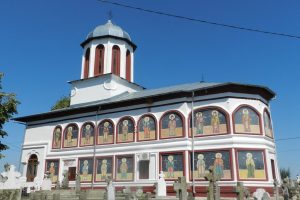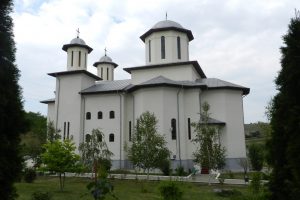

The church, of modest size, has a cross form with rectangular narthex separated from the nave by a wall with three equal openings . The nave, very high, is covered by a dome on four arches that support the foundations of a former octagonal tower collapsed on an unknown date. As particular elements, the windows, four in number, two in the nave and two in the narthex, are without framing and the iconostasis is of mansonry. The exterior walls, presents expressive playing rows of apparent bricks and mortar boxes, with two rows of niches separated by a simple brick waist. Interior painting, of recent date, preserves only in spirit the original one. Thus, the votive picture and the inscription presents his presumed founders from the reports of those who saw the old fresco.In the north of the church, towards the road in 1964,were, still to be seen, ruins of buildings belonging to the former cells. The inscription, rewritten 60 years ago, apparently different from the original states that: This holy and divine church, which is dedicated to Candlemas , founded by Costache Ghica the days of Matei Basarab, whose illustrations are into the chamber of women […]. To support this, historian Ion Ionaşcu who saw the old votive fresco, states that the painting of the founders had, (at that time), […] still, well preserved, the figure of Matei Basarab […] in days of which the church was built by someone called Constantin Ghica. The problem regarding the founder’s name was thought seriously given that, during the reign of Matei Basarab was no question of a family Ghica, moreover, this family never had possession of the estate Curtişoara.
In the beginning of the eighteenth century the village Curtisoara goes into dominion of great sluger Tudor Rudeanul , who would call himself in acts ot Ruda and Curtişoara. The same cognomen had to wear its second son, Chirca seneschal, the heir to Curtisoara domain. It is possible that the name Ghica , to be a misinterpretation of the Chirca name due to the deterioration of the old inscription and its successive rescripts. Nevertheless, in the text of an inscription of an icon of the Virgin, dated 1624-1625, belonging to the church in Rudeni village, the boyars Rudeanu’s estate home, the art critic G. Teodorescu deciphered in 1929, in a list of seven or eight names, the name of Ghica along with that of a certain Despa a character possibly identifiable with the second wife of Tudor Rudeanul. The remaining names translated by G. Teodorescu not included among the family members attested at the time. What is certain is that the hermitage is mentioned in documents much later, as the Metropolitan Metohija, in two acts from March 1, 1766 June 19, 1777.
In 1899, Pulcheria Munteanu, born Hiotu, descendant of the of Rudeni family of the seventeenth century, initiates, together with locals, a number of repairs quite important to the church, and in 1916, Ilarian Marian, then, the owner of the estate, brings a number of great improvements in masonry and in painting, on this occasion changing the patron into whom it is today. The last major restoration is the one in 1955 made at the expense of parishioners when is given the current layout.


